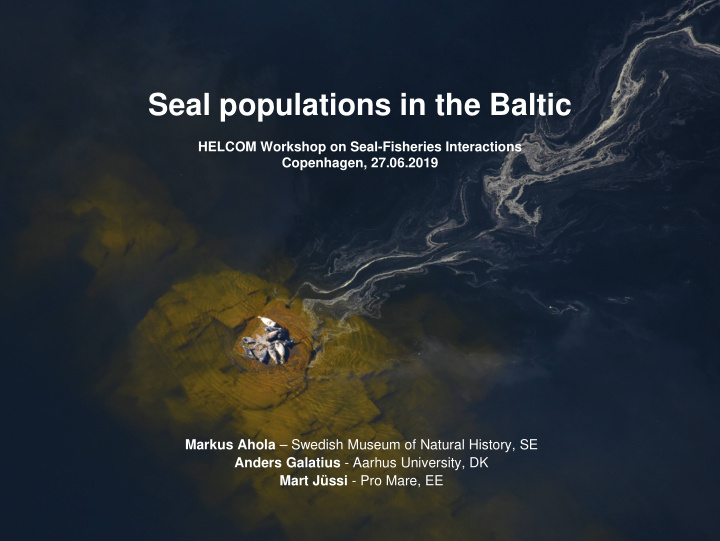



Seal populations in the Baltic HELCOM Workshop on Seal-Fisheries Interactions Copenhagen, 27.06.2019 Markus Ahola – Swedish Museum of Natural History, SE Anders Galatius - Aarhus University, DK Mart Jüssi - Pro Mare, EE
Seal populations in the Baltic Common basis for monitoring - HELCOM • Recommendation 27/28-2 Three seal species : grey seal, ringed seal, • harbour seal Current status and perspectives for the • future Good environmental Status (GES) and • HELCOM assessment (HOLAS II)
The HELCOM Recommendation 27/28-2 (The Seal Recommendation) NOTING that the proposed General Management Principles are the following which link the seal populations to the Baltic Sea Ecosystem : · populations size (with the long-term objective to allow seal populations to recover towards carrying capacity levels); · distribution (with the long-term objective to allow breeding seals to expand to suitable breeding distribution in all regions of the Baltic ); and · health status (with the long-term objective of attaining the health status that secures the continued existence of the populations);
The HELCOM Recommendation 27/28-2 (The Seal Recommendation) ALSO NOTING that the HELCOM/ICES/EU Seal Expert Workshop defined and agreed on the following Management Units for Baltic Sea seal populations: 1) Harbour seals in the Kalmarsund region (Sweden); 2) Southwestern Baltic harbour seals (Denmark, Germany, Poland, Sweden); 3) Gulf of Bothnia ringed seals (Finland, Sweden); 4) Southwestern Archipelago Sea, Gulf of Finland and Gulf of Riga ringed seals (Finland, Estonia, Latvia, Russia); 5) Baltic Sea grey seals ( all Contracting Parties to the Helsinki Convention);
Current monitoring methods for abundance • Counts are aerial surveys during peak RS moulting period – Ringed seals after mid-April – Grey seals in late May - early June – Harbour seals in mid-August RS • During their annual moult seals spend the largest proportion of their time hauling out on land or ice and are available for counting GS • The monitoring in Baltic is internationally coordinated among experts in HS HELCOM EG MAMA
Current monitoring methods for distribution • Distribution in the sense of Seal RS Recommendation management objective deals with breeding distribution • In many management applications distribution of known haul-outs is used , e.g. for defining special protected areas or RS assessing environmental impacts. BUT GS • The seals can move freely in the marine environment and spend over 70% of total time diving in summer season. HS
Grey seal monitoring • Grey seals gather to islets and skerries in outer archipelago and coastal zone • All haulouts are surveyed 2-3 times within a two-week period in the end of May - beginning of June, new locations searched during the surveys • The seals are photographed and their numbers counted from the photos • The largest daily result for each sea area is used as abundance index 240
Grey seal monitoring (example)
Grey seal monitoring (Estonian example, 2017) 1781
Grey seal abundance trends Abundance index in 2017 ~30 000 and average annual increase +4.9 %/year (%/year) during 2003-2017 2 000 +3.9 % The whole Baltic: ~ 30 000, 60-80 % of the 2 100 total population size of +9.0 % > 80 % 37 500–50 000 8 100 +0.9 % Geographically 800 describes the 11 100 +1.0 % +8.0 % situation during the peak moult! 4 000 +3.8 % 2003-2018: 2 600 3 500 +20.0 % +20.7 %
Grey seal offshore distribution Adult male seal (14.7.07+ 242 d ) Adult female seal (14.7.07 + 261 d)
Ringed seal monitoring • Bothnian Bay: – Aerial transect line methodology – Transects evenly spread over the ice- covered area – Flying altitude 90 m, survey strips 400 m on both sides – Survey strips give a sample of min 13 % of the ice-covered area – All seals on the survey strips are photographed and counted from the photos – The counted number is then multiplied from the sample to the whole area – The result is used as abundance index Härkönen & Lunneryd, Ambio 1992
Southern Ringed seals • The Archipelago Sea, Gulf of Finland and Western Estonia: – Aerial surveys possible only on good enough ice-years – In the Archipelago Sea the whole area between the transect lines is observed – Monitoring methods for ice-free circumstances under development
Ringed seal abundance trends Two management units: - Bothnian Bay - The Archipelago Sea, Gulf of Finland and W- > 20 000 Estonia - Annual increase 4.7 % in Bothnian Bay ~200-300 ~100 ~1 000 - No increase in other areas
Ringed seal offshore distribution: migration
Ringed seal offshore distribution: feeding
Ringed seals breeding success and climate change Up to six weeks of stable ice needed for ringed seals
Grey seal breeding success and climate change Up to 50% neonatal mortality (5%) Up to 20% less energy reserves
Summary of greys and ringed seals • Baltic seal populations are recovering • There are some indications of approaching carrying capacity in grey seal • Gulf of Finland ringed seal is on the verge of extinction • Climate warming is an increasing challenge for ringed seals • Improving monitoring methods for better understanding of seals’ abundance and it’s variations in time and space
Recommend
More recommend